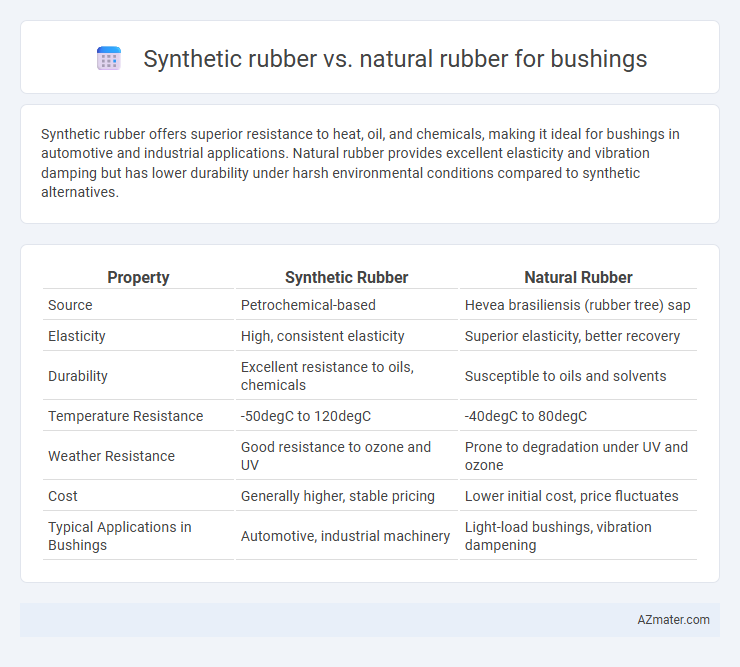Synthetic rubber offers superior resistance to heat, oil, and chemicals, making it ideal for bushings in automotive and industrial applications. Natural rubber provides excellent elasticity and vibration damping but has lower durability under harsh environmental conditions compared to synthetic alternatives.
Table of Comparison
| Property | Synthetic Rubber | Natural Rubber |
|---|---|---|
| Source | Petrochemical-based | Hevea brasiliensis (rubber tree) sap |
| Elasticity | High, consistent elasticity | Superior elasticity, better recovery |
| Durability | Excellent resistance to oils, chemicals | Susceptible to oils and solvents |
| Temperature Resistance | -50degC to 120degC | -40degC to 80degC |
| Weather Resistance | Good resistance to ozone and UV | Prone to degradation under UV and ozone |
| Cost | Generally higher, stable pricing | Lower initial cost, price fluctuates |
| Typical Applications in Bushings | Automotive, industrial machinery | Light-load bushings, vibration dampening |
Introduction to Rubber Bushings
Rubber bushings are essential components in automotive and industrial applications, providing vibration isolation and noise reduction. Synthetic rubber, such as neoprene or polyurethane, offers enhanced durability, chemical resistance, and temperature tolerance compared to natural rubber, which excels in elasticity and flexibility but degrades faster under harsh conditions. Selecting the appropriate rubber material directly impacts the bushing's lifespan and performance in dynamic environments.
What Are Natural Rubber Bushings?
Natural rubber bushings are vibration-absorbing components made from latex harvested from rubber trees (Hevea brasiliensis), prized for their excellent elasticity, high tensile strength, and superior tear resistance. These bushings perform well under dynamic loads, maintaining flexibility across a wide temperature range, which is crucial for automotive and industrial suspension systems. Their biodegradable nature and ability to dampen noise and vibration make them a preferred choice over synthetic alternatives in applications demanding natural material properties.
What Are Synthetic Rubber Bushings?
Synthetic rubber bushings are engineered elastomer components made from petrochemical-based polymers like neoprene, nitrile, or EPDM, designed to provide enhanced durability and resistance to oil, heat, and abrasion compared to natural rubber. These bushings are commonly used in automotive and industrial applications for vibration damping, noise reduction, and flexible joint support, offering superior performance in harsh environments. Their chemical stability and customizable hardness make synthetic rubber bushings ideal for high-stress mechanical assemblies where longevity and reliability are critical.
Key Differences: Natural vs Synthetic Rubber
Natural rubber offers superior elasticity and resilience, making it ideal for bushings requiring high flexibility and impact absorption. Synthetic rubber provides enhanced resistance to heat, oils, and chemicals, ensuring better durability in harsh environmental conditions. The choice between natural and synthetic rubber bushings depends on specific application requirements such as temperature range, exposure to contaminants, and mechanical stress.
Performance Comparison in Various Conditions
Synthetic rubber bushings exhibit superior resistance to temperature extremes, ozone, and chemical exposure compared to natural rubber, making them ideal for automotive and industrial applications. Natural rubber offers excellent elasticity and high tensile strength, providing better vibration damping and flexibility under dynamic loads. Performance evaluation under varying conditions highlights synthetic rubber's durability and longevity, while natural rubber excels in environments requiring superior resilience and comfort.
Durability and Lifespan Factors
Synthetic rubber bushings offer superior durability and resistance to environmental factors such as ozone, oil, and temperature variations compared to natural rubber, extending their lifespan significantly in harsh conditions. Natural rubber bushings, while providing excellent elasticity and cushioning, tend to degrade faster due to susceptibility to oxidation, UV exposure, and microbial attack, which shortens their effective lifespan. The choice between synthetic and natural rubber for bushings depends on the specific application's exposure to stresses, with synthetic variants preferred for longevity and consistent performance under demanding conditions.
Cost Considerations: Which Is More Affordable?
Synthetic rubber generally offers a more affordable option for bushing applications due to its consistent manufacturing process and scalability. Natural rubber, while providing excellent elasticity and resilience, can be more expensive because of variable raw material costs influenced by climate and harvesting conditions. For cost-conscious projects, synthetic rubber typically delivers better price stability and lower overall expenses.
Environmental Impact Assessment
Synthetic rubber used in bushings typically derives from petrochemical sources, leading to higher carbon emissions and non-biodegradability compared to natural rubber. Natural rubber, harvested from Hevea brasiliensis trees, offers renewable and biodegradable properties, significantly reducing environmental impact during lifecycle stages. However, large-scale natural rubber cultivation may contribute to deforestation and biodiversity loss, necessitating sustainable sourcing practices in environmental impact assessments.
Application Suitability: Choosing the Right Bushing
Synthetic rubber offers superior resistance to oil, chemicals, and temperature extremes, making it highly suitable for bushings in automotive and industrial machinery exposed to harsh environments. Natural rubber provides excellent flexibility, elasticity, and vibration damping, ideal for bushings in applications requiring higher resilience and shock absorption under moderate conditions. Selecting the right bushing depends on matching synthetic rubber's durability and chemical resistance with natural rubber's comfort and elasticity requirements in specific operational contexts.
Conclusion: Which Rubber Bushing Is Best?
Synthetic rubber bushings offer superior durability, resistance to heat, oil, and chemicals, making them ideal for harsh automotive and industrial environments, while natural rubber bushings provide excellent flexibility and vibration damping but degrade faster under extreme conditions. The best rubber bushing depends on specific application requirements; synthetic rubber is preferred for longevity and performance in demanding settings, whereas natural rubber may be suitable for less aggressive environments needing better elasticity. Evaluating factors such as load, exposure to chemicals, temperature range, and desired lifespan is critical in selecting the optimal bushing material.

Infographic: Synthetic rubber vs Natural rubber for Bushing
 azmater.com
azmater.com